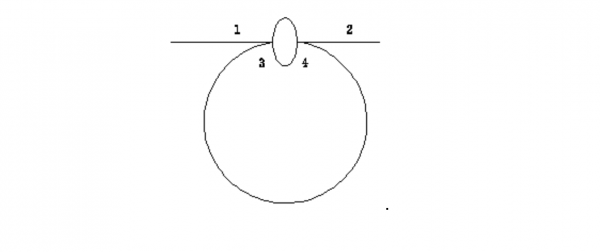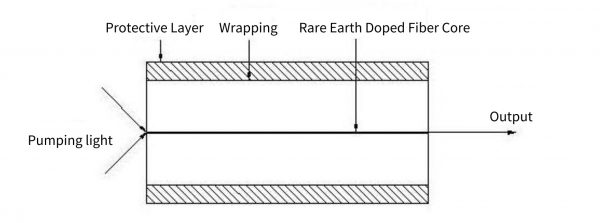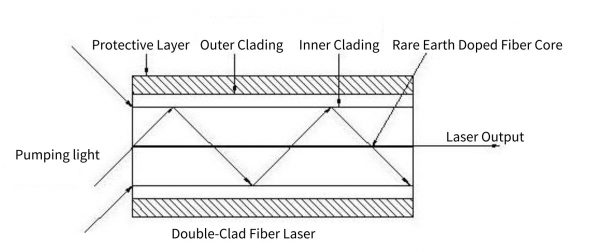What is a Fiber Laser?
This article introduces the structure, types, and basic parameters of fiber laser.
Structure of fiber laser
To generate laser, three basic conditions must be met: working medium, pump source and resonator. Fiber lasers generally use doped fiber as the working medium, and use fiber grating, fiber ring mirror or fiber end face as a reflector to form a feedback cavity. Fiber lasers generally use optical pumping, and the pump is coupled into the fiber. Because the fiber core is very thin, it is easy to form a high power density in the fiber under the action of the pump light, resulting in a “number inversion” on the energy level of the laser working medium. ”, together with a suitable feedback device to form a resonant cavity, can generate laser oscillation.
1. Pumping method
(1) Low-power LD end-face pumping. Using a certain coupling system to focus the pump light on the surface of a small laser medium can achieve high pump power density at the surface of the laser and achieve high-efficiency pumping of the laser medium. The single-mode fiber core diameter of this low-power laser With only 9um, it can only use end-face pumping and cannot withstand too high power density. At the same time, the single-mode fiber core puts forward strict requirements on the mode of the LD. Only single-mode light can be coupled into the fiber core for effective pumping. However, high-power single-mode LD has not been able to achieve so far, and this structure has been limited to the field of optical communication.

(2) High-power pumping. One of the typical structures uses bifurcated fibers for side pumping in time, and its structure is shown in the figure

2. Resonator structure
(1) Linear cavity
a. DBR light laser. The DBR fiber laser uses two fiber gratings with higher reflectivity as mirrors, which are placed at both ends of the doped fiber to form a linear laser resonator to enhance mode selection

b.DFB fiber laser. The resonant cavity is formed by using gratings directly written in rare earth doped fiber.

(2) Annular cavity
The structure of the fiber ring resonator is shown in Fig.

3. Gain medium
Most of the light lasers now use doped fiber as the gain medium. At present, the rare earth ions doped in the mature active fibers are Er3+, Nd3+, Yb3+. Erbium-doped fiber has a high gain at the wavelength of 1.55um, corresponding to the third communication window with low loss. Due to its potential application value, erbium-doped fiber lasers have developed very rapidly. Ytterbium-doped fiber laser is a general source with wavelengths of 1.0-1.2um. Yb3+ has a relatively wide absorption band (800-1064nm) and a relatively wide excitation band (970-1200nm), so the choice of pump source is very wide and the pump source and lasers are not subject to excited state absorption.
Types of Fiber Lasers
1. According to the type of fiber material, fiber lasers can be divided into:
(1) Crystal fiber laser. The working material is laser crystal fiber, mainly including ruby single crystal fiber laser and Nd3+:YAG single crystal fiber laser.
(2) Nonlinear optical fiber lasers. There are mainly stimulated Raman scattering fiber lasers and stimulated Brillouin scattering fiber lasers.
(3) Rare earth doped fiber lasers. The matrix material of the optical fiber is glass, and rare earth element ions are doped into the optical fiber to activate it to make a fiber laser.
(4) Plastic fiber laser. Fiber lasers are made by doping laser dyes into the core or cladding of plastic optical fibers.
2. According to the type of fiber structure, fiber lasers can be divided into:
(1) Single-clad fiber laser

(2) Double-clad fiber laser
Double-clad fiber consists of four parts: core, inner cladding, outer cladding, and protective layer. The core is composed of SiO2 doped with rare earth elements, which is the channel of laser oscillation and is single-mode for the relevant wavelength; the inner cladding is composed of SiO2 whose lateral size and numerical aperture are much larger than those of the core, and the refractive index is smaller than that of the core. The channel of the pump light is multi-mode for the wavelength of the pump light; the outer cladding is composed of a material with a smaller refractive index than the inner cladding; the protective layer is surrounded by hard plastic to protect the fiber.

3. According to the time-domain characteristics of laser output, fiber lasers can be divided into:
(1) CW laser
(2) Pulsed laser
The Q switch is the core device of the Q-switched fiber laser. According to the basic principle of the Q-switched laser, when selecting the Q-switch, there are key laser factors that must be considered: one is the extinction ratio of the switch in the high-loss state and the low-loss state. The second is the switching time It should be as short as possible. Third, the insertion loss of the Q switch should be as small as possible to obtain the output of high peak power and high pulse energy. At present, the widely used Q-switches are mainly divided into non-fiber type and all-fiber type. Non-fiber type Q-switches include acousto-optic Q-switches, electro-optic Q-switches, saturable absorbers, etc. Adjustable fiber grating Q-switching, fiber-type saturable absorber Q-switching, etc.
Seed Pulse Master Oscillation Amplified (MOPA) light laser. The seed source oscillation amplified fiber laser has high single pulse energy, large average output power, wide tuning range and good beam quality, and is an ideal pulse output laser. It is usually obtained by a mode-locked laser or a Q-switched laser, and the amplification gain medium is a rare-earth-doped double-clad fiber. The release of ultrashort pulses in the fiber is limited by the extractable energy, which is determined by the saturation energy threshold, the signal gain and the area of the excitation medium. In order to increase the power as much as possible, it is necessary to solve the contradiction between the limitation of the fiber length due to the nonlinear effect in the light and the need for a longer fiber to absorb the pump light more fully. Increasing the core diameter is a better solution.
Basic parameters of fiber laser performance
(1) Optical properties
Optical properties include the following parameters: operating mode, polarization state, maximum average output power, pulse repetition rate, pulse energy, central emission wavelength, lasing bandwidth, pulse width, tuning range, indicated laser wavelength
(2) Beam output and isolator characteristics
The beam output characteristics include the following: output spot diameter, beam quality, divergence angle/output fiber length, power output stability, strong back reflection working time, and output fiber length.
Characteristics of output isolation include the following: isolator size, isolator operating temperature, output isolator weight
